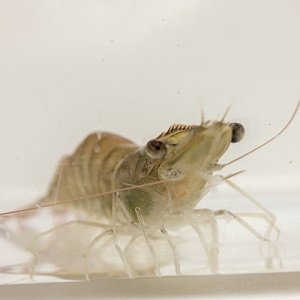
Achieving optimal productive efficiency in Pacific white shrimp (Litopenaeus vannamei) aquaculture requires careful management of stocking densities, especially in innovative systems such as biofloc and mixotrophic aquaculture.
A recent study published in the North American Journal of Aquaculture by researchers from Auburn University and the U.S. Department of Agriculture–Agricultural Research Service explains how different stocking densities affect shrimp growth, survival, and feed conversion ratio (FCR) in biofloc and mixotrophic systems.
The importance of stocking density in shrimp farming
Stocking density plays a fundamental role in aquaculture. While higher densities can maximize biomass production, they often lead to reduced individual growth, increased stress, and poorer water quality. Balancing these factors is essential for both economic viability and shrimp welfare.
The study conducted by Bajracharya evaluated the effects of varying stocking densities on Pacific white shrimp in two systems: an indoor biofloc-based recirculating system and an outdoor mixotrophic system. The findings provide valuable insights for shrimp farmers looking to optimize their operations.
Key findings of the study
Indoor Biofloc system
In the indoor biofloc system, shrimp were stocked at densities ranging from 67 to 533 shrimp/m³. The results showed a clear trend: as stocking density increased, so did the final biomass. However, individual shrimp growth decreased. At the lowest density (67 shrimp/m³), shrimp reached the highest average weight of 6.0 g and a weight gain of 546%. In contrast, at the highest density (533 shrimp/m³), the average weight decreased to 4.9 g, and weight gain dropped to 414.8%.
- Final Biomass: Increased significantly with higher stocking densities, reaching 359.9 g at 533 shrimp/m³.
- Survival Rates: Remained high (90-98.6%) across all densities, indicating the robustness of the biofloc system.
- Feed Conversion Ratio (FCR): The lowest FCR (1.6) was observed at the lowest density, and FCR increased as density increased.
Outdoor Mixotrophic system
In the outdoor mixotrophic system, shrimp were stocked at densities ranging from 50 to 400 shrimp/m³. As in the biofloc system, higher densities resulted in increased biomass but reduced individual growth. At the lowest density (50 shrimp/m³), shrimp reached the highest average weight of 16.8 g and a weight gain of 4,040%. At the highest density (400 shrimp/m³), the average weight decreased to 11.6 g, and weight gain dropped to 2,736.2%.
- Final Biomass: Increased significantly with higher densities, reaching 2,836.1 g at 400 shrimp/m³.
- Survival Rates: Decreased at higher densities, with the lowest survival rate (70.5%) observed at 400 shrimp/m³.
- Feed Conversion Ratio (FCR): The lowest FCR (0.8) was achieved at the lowest density, and FCR increased as density increased.
Implications for the shrimp farming industry
The study highlights a critical trade-off in shrimp farming: higher stocking densities can increase total biomass but often result in smaller individual shrimp and higher FCRs. Conversely, lower densities promote faster growth and larger shrimp but produce lower total biomass.
For shrimp farmers, the choice of stocking density should align with specific production goals:
- Maximizing Yield: If the goal is to maximize total biomass, higher stocking densities may be appropriate, but farmers must be prepared to manage associated challenges such as increased FCR and potential declines in water quality.
- Larger Shrimp: If the market demands larger shrimp, lower stocking densities are preferable, as they allow each shrimp to access more resources and grow more efficiently.
Managing water quality and feed efficiency
Effective water quality management is crucial, especially at higher stocking densities. The study revealed that both biofloc and mixotrophic systems maintained adequate water quality parameters during trials, but higher densities can strain these systems. Regular monitoring of dissolved oxygen levels, pH, ammonia, and nitrite is essential to ensure optimal shrimp growth conditions.
Feed efficiency also plays a significant role. The study observed that lower stocking densities resulted in better feed conversion ratios (FCR), meaning shrimp converted feed into body mass more efficiently. This has direct implications for production costs and profitability. Aquaculturists should consider adjusting feeding practices and feed formulations to optimize FCR, particularly at higher densities.
Conclusion
The findings of this study underscore the importance of carefully selecting stocking densities based on production goals and system capabilities. While higher densities can increase total biomass, they may compromise individual growth and feed efficiency. On the other hand, lower densities support larger shrimp and better feed conversion ratios (FCR) but yield lower total biomass.
For shrimp farmers, the key is to balance maximizing yield with maintaining shrimp health. By understanding the dynamics of stocking density in biofloc and mixotrophic systems, producers can make informed decisions that enhance both productivity and profitability.
Reference (open access)
Bajracharya, S., Roy, L. A., García, J. C., & Davis, D. A. Stocking density and growth of Pacific white shrimp Litopenaeus vannamei in intensive recirculating (indoor biofloc and outdoor mixotrophic) systems. North American Journal of Aquaculture. https://doi.org/10.1093/naaqua/vrae004
Editor at the digital magazine AquaHoy. He holds a degree in Aquaculture Biology from the National University of Santa (UNS) and a Master’s degree in Science and Innovation Management from the Polytechnic University of Valencia, with postgraduate diplomas in Business Innovation and Innovation Management. He possesses extensive experience in the aquaculture and fisheries sector, having led the Fisheries Innovation Unit of the National Program for Innovation in Fisheries and Aquaculture (PNIPA). He has served as a senior consultant in technology watch, an innovation project formulator and advisor, and a lecturer at UNS. He is a member of the Peruvian College of Biologists and was recognized by the World Aquaculture Society (WAS) in 2016 for his contribution to aquaculture.
